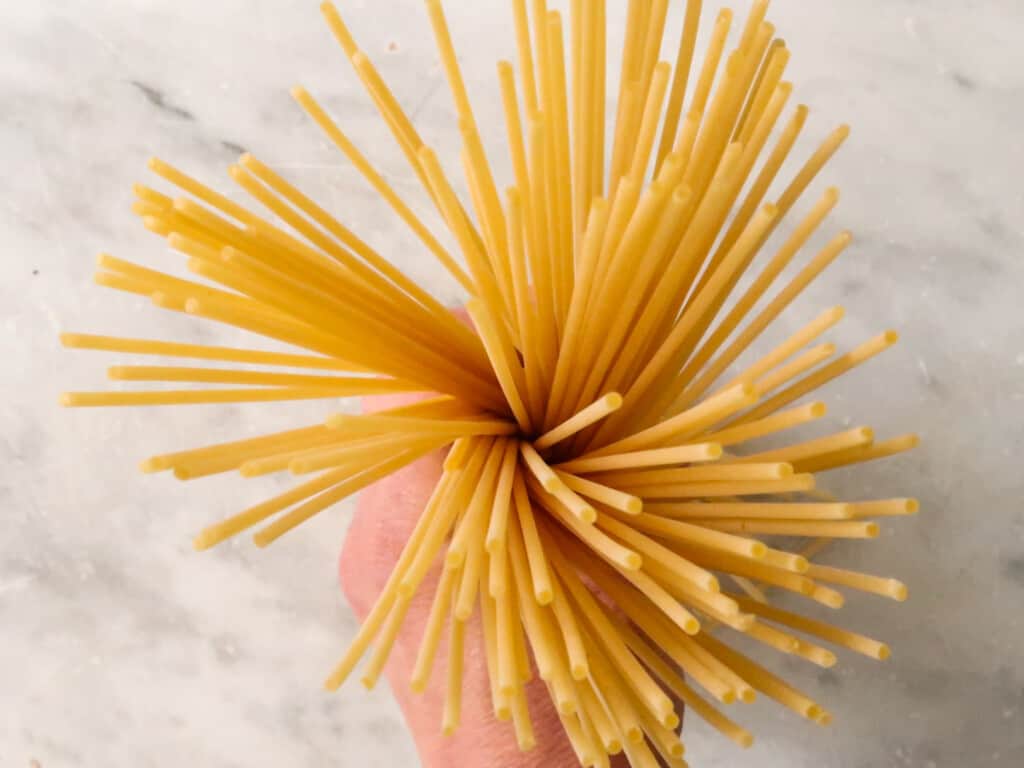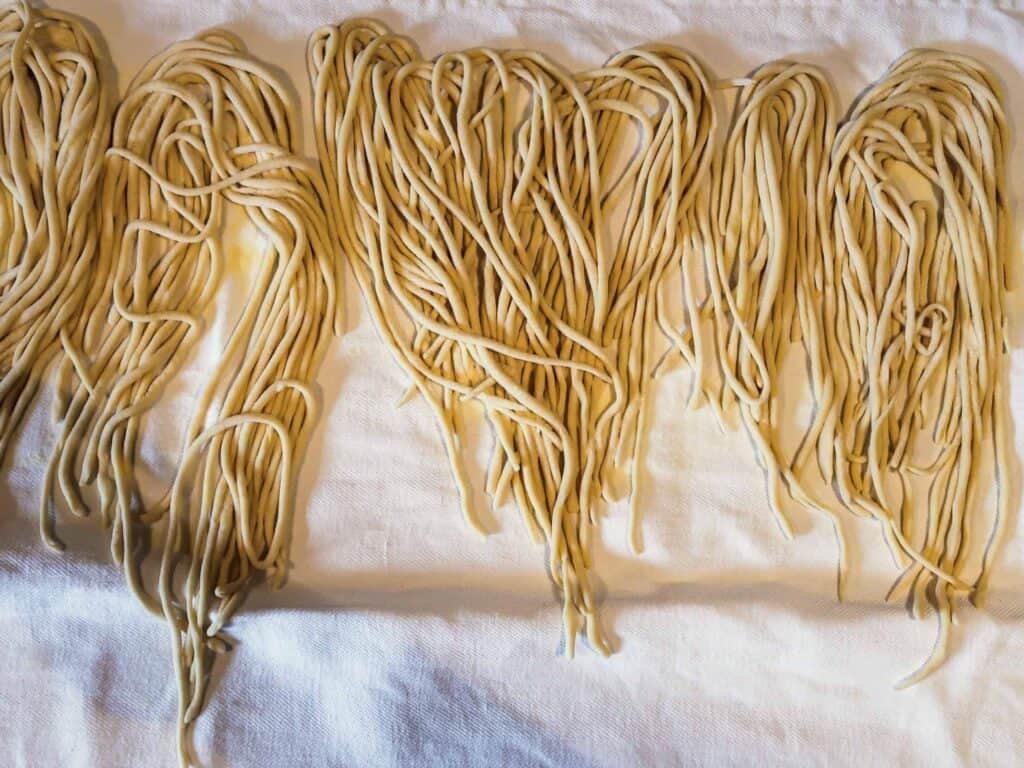Last updated on November 3rd, 2023
Anyone who is confused with Italian flour keep reading please. Types? Names? Recipes? Substitutions? There are so many questions to answer and things to know about Italian flour!
I honestly wasn’t that familiar with all of the Italian flour varieties until about five years ago when I initiated my startup, Make and Bake in Italy, selling high-quality boxed American dessert mixes. When I first started, I thought I would multiply my favorite recipes by 1,000, box them up and bam – boxed cake mixes in Italy. WRONG!
I had to figure out the flours first! I couldn’t just tell the manufacturer to add “all-purpose flour” because we don’t have it here in Italy.
After close study, experiment, and practice, I think I have it nailed down.
Let’s take a loot at:
- the different kinds of Italian flour
- the American equivalents of Italian flour
- what Italian flours are used for
- characteristics of Italian flour
- tips for Italian flour substitutions
Jump to Section
Italian Flour – Basics
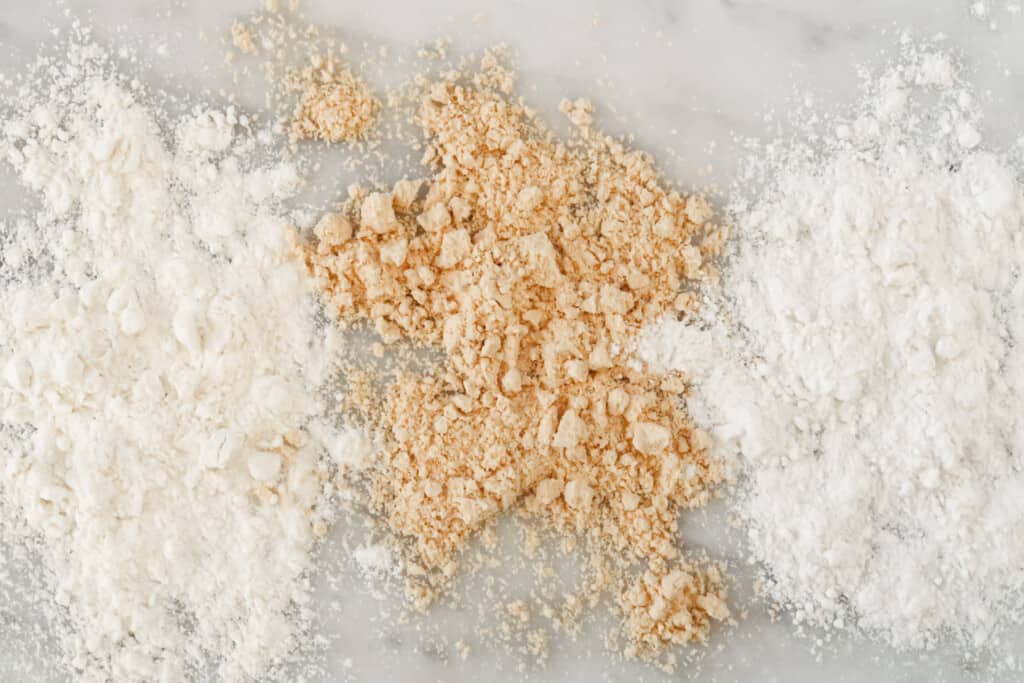
Flour in Italian is farina.
Farina is pronounced fah-ree-NAH.
In this article, we are talking about wheat flour (although you can also find different kinds, such as rice and almond in Italy – see below for substitutions). Italian wheat flour is characterized and sold in terms of the type of grain, the flour strength (meaning the gluten protein content), and the grind (meaning how finely or coarsely it is ground).
| Category | USA Name | Number/Name | Characteristics | Strength | What It Is Used For | Available Online |
| Grano tenero | pastry flour | 00 | white/finest grind | 9% | pastry with no yeast, fresh pasta, sauces and pastry creams | Tipo 00 on Amazon |
| Grano tenero | all purpose flour | 0 | white/very fine | 11% | pastry with yeasts, focaccia, pizza | Tipo 0 on Amazon |
| Grano tenero | high gluten /bread flour | 1 | white/fine | 13% | bread | Tipo 1 on Amazon |
| Grano tenero | semi-whole wheat flour | 2 | white with bran | 12% | bread | |
| Grano tenero | whole wheat flour | integrale | whole wheat | 12% | whole wheat bread | Integrale on Amazon |
| Grano tenero | N/A | manitoba | higher protein content milled either 0/00 | 12% | bread and pizza, pinsa, schiacciata | Manitoba on Amazon |
| Grano duro | semolina (durum wheat flour) | semolina/semola | durum wheat flour/yellow and more course | 10.5% | mixed with grano tenero for bread and pasta | Semolina flour on Amazon |
| Grano duro | Whole wheat semolina | semolina/semola integrale | whole wheat durum | 11.5% | mixed with grano tenero for bread and pasta | Semola di grando duro on Amazon |
| Grano duro | N/A | semola rimacinata | twice milled durum wheat | 14% | mixed with grano tenero for bread and pasta | Semola rimaccinato on Amazon or this |
Italian Flour – Grain Type

The two main umbrella categories for wheat flour in Italy are grano tenero (or soft wheat flour, which is very pillowy and often white) or grano duro (literally translating to “hard wheat” or semolina flour).
Fact: Grano tenero and grano duro are categories specifically designated for wheat flours, not other grains.
Grano Duro
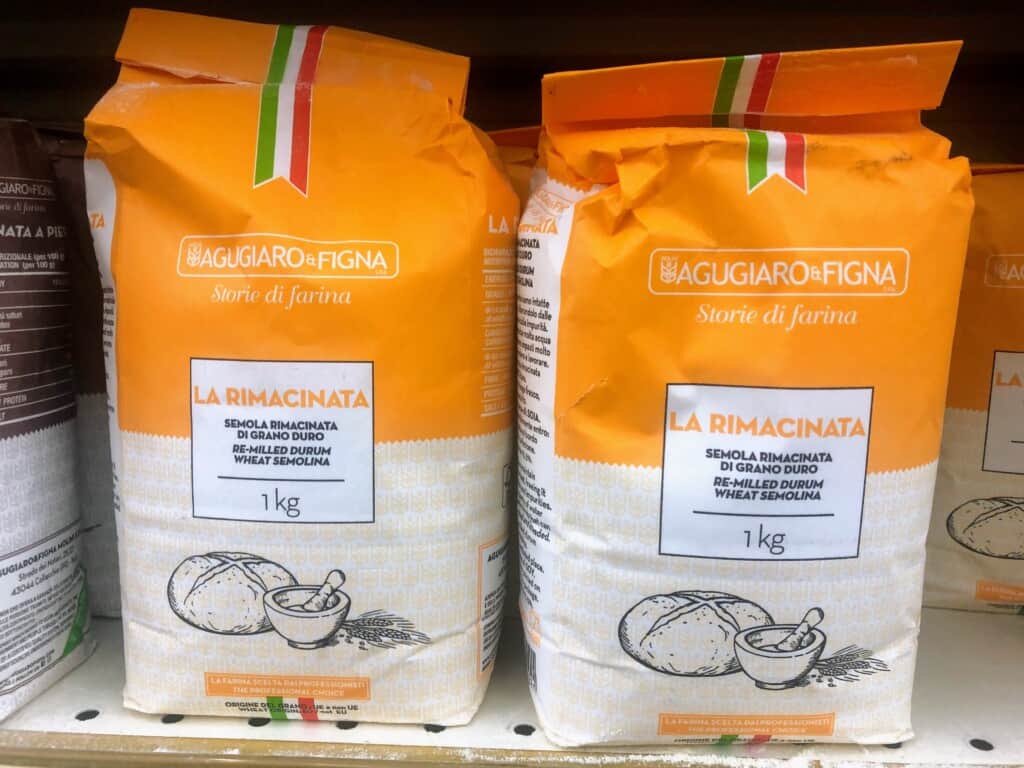
Grano duro, also known as durum wheat flour or semolina, is slightly yellow, very granular, and mostly used for pasta and bread making in southern Italy.
Fact: A very common use of grano duro or semolina flour in Italy is in the final step of fresh pasta making. After the pasta has been shaped, it’s lightly tossed in grano duro to keep it from sticking together. It’s fundamental if you are making pasta for the first time at home!
Grano Tenero
This is what American and Canadians know as white flour which can be further categorized by strength and grind (often in numbers) such as pastry flour, bread flour, and all-purpose flour.
Italian Flour – Flour Strength
Flour strength indicates the amount of gluten in the flour. The stronger the flour, the higher the gluten content will be, which means more water can be absorbed into whatever you make (bakers, you know this is important for creating elastic, hydrated doughs such as sourdoughs).
W-Value

The w-value is the value of the protein content in the flour.
- Weak flour: a low gluten content hovers between about 8-9% with a w-value of between 90-180. This is ideal for doughs that won’t rise much yet will retain a good amount of moisture.
- Medium flour: a gluten content between 9-12% with a w-value of between 200-300. This is good for everyday use such as muffins, pancakes, loaf cakes, and fast-rising yeasted breads.
- Strong flour: flour with a gluten content over 12% with a w-value of over 300. This is ideal for sourdough breads and slow-rise baking where the gluten proteins must form to hold air, hydration and shape.
Bonus: Super glutinous flour has a w-value of over 350, a gluten content of between 15-16%! I have never used this.
How to Figure Out the W-Value in Italy on Any Flour
Simply check out the nutritional info on the back. They typically give the natitional value for 100 grams of flour. If this is the case, look at the protein towards the bottom and note the grams. If it is 9 grams it is 9% and thus weak, 11 grams, it’s 11% and thus, medium and 13 grams, it’s 13% and thus, strong flour.
Italian Flour – Grind
Grind or macinazione in Italian means how finely or coarsely the flour has been ground.
Farina 00
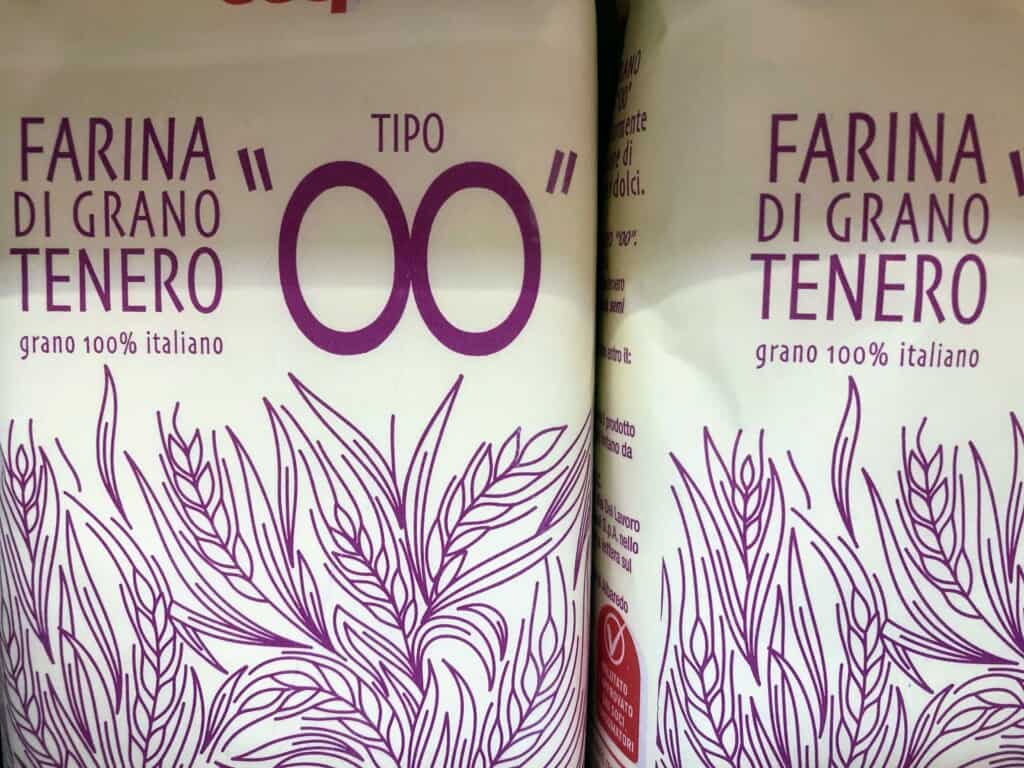
Doppio zero, or double zero flour is what Americans call pastry flour or baking flour. It’s the most refined flour with a low gluten content that is sold with all impurities removed and ground extremely fine. It’s used mostly for desserts and baking such as pastry creams, puddings and cakes, especially very luxuriously smooth and airy desserts such as the classic Italian pastry creme (which you will find in a ton of Italian recipes and every morning at the Italian bar in the brioche con crema). This is also flour that Italians use for making egg pasta dough. If a recipe calls for this flour, try and stick to it as a change will affect the consistency of the food you are making.
Farina 0

This white flour known as farina tipo zero in Italian is the equivalent to American all-purpose flour. It can be used for general cooking and baking purposes such as for muffins, yeasted breads, pancakes and rustic cakes. It’s slightly less refined and coarser than 00 flour.
Farina 1

Also known as farina tipo uno in Italian, this is slightly darker and coarser than 0 flour. It’s stronger and has a higher gluten content, ideal for making slow-rise breads. The darkness comes from a bit of wheat germ and bran that is not sifted out, unlike in farina 0 and 00.
Fact: Substitute farina 0, 1 and 2 with one another in equal parts and try coming up with your blends on personal preferences. Generally speaking, your recipe shouldn’t change too much when substituting between these flours.
Farina 2

This flour is considered a semi-whole wheat flour that is slightly darker and coarser than farina 1. There is much more bran left in the flour, making it look speckled with bits of tiny bran flakes. I love this as an everyday flour for making things such as focaccia, muffins, pancakes and even simple rustic cakes because it has a higher protein content and much more fiber.
Integrale

This whole wheat flour is the darkest and coarsest of all the Italian flours because it uses the whole wheat berry instead of sifting out the wheat germ and bran. It’s quite dark with a higher protein content. Many Italians, including myself, mix farina integrale with other flours such as farina 0 to get a nutty flavor without weighing down the recipe.
Substitution Tip: Try substituting a portion of the flour in a recipe for whole wheat to add a richness and nutty flavor to your recipe. I love doing this in breads and pizza dough.
Bonus: Farina Manitoba

The term manitoba in Italian refers to a variety of hard wheat grown in North America with a high protein content. Oftentimes, this flour variety is mixed in with others directly at the mill to produce a specialized flour for bread or pizza that will develop gluten well, making for the ideal dough consistency. You can buy it either as tipo 0 or 00.
Alternative Flours in Italy
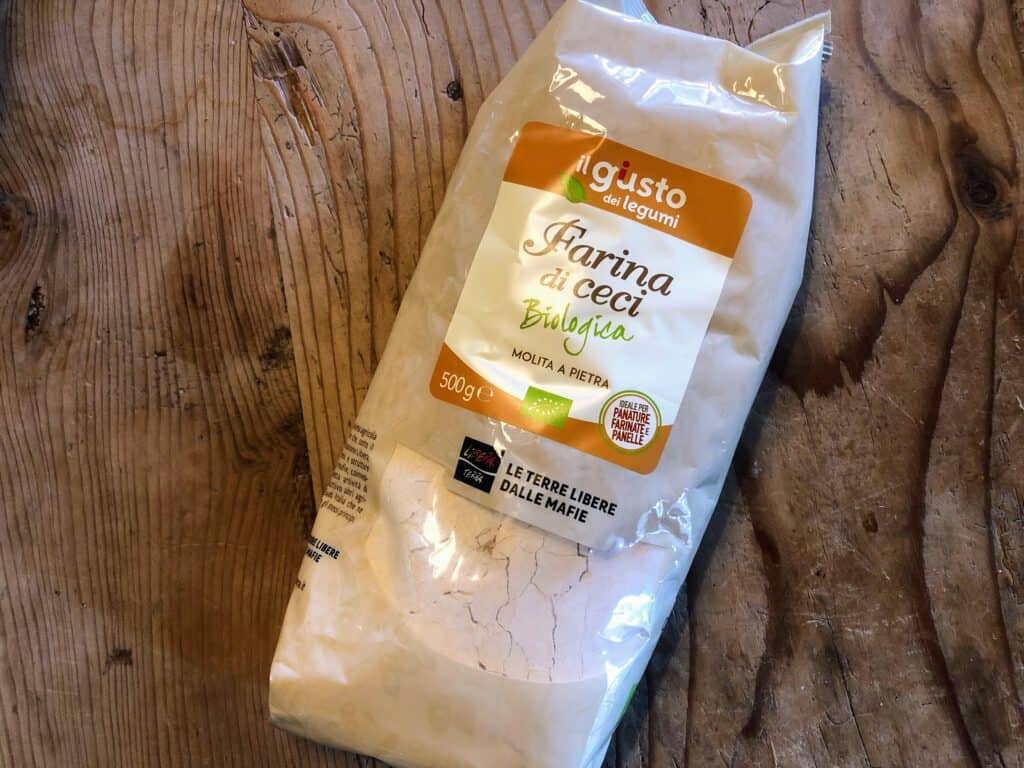
Like many countries, Italy has plenty of wheat alternatives in part due to allergies but also due to regional culinary preferences and traditions.
- Riso: rice flour is a common substitute for gluten intolerances and an important ingredient in making pizza pinsa.
- Mandorla: almond flour is harder to come by but can be found in specialty supermarkets. It’s used in some Italian cookie recipes but primarily as a substitute for gluten intolerance.
- Grano saraceno: buckwheat flour is used more commonly in northern Italy in pasta recipes and griddle pancake recipes.
- Castagna: chestnut flour is milled once a year in the fall and used in castagnaccio, a traditional unleavened chestnut cake.
- Ceci: chickpea flour used as an alternative in pasta, produced on the industrial level and also in a very popular chickpea pancake recipe known as cecina.
Best Italian Flour for Pizza
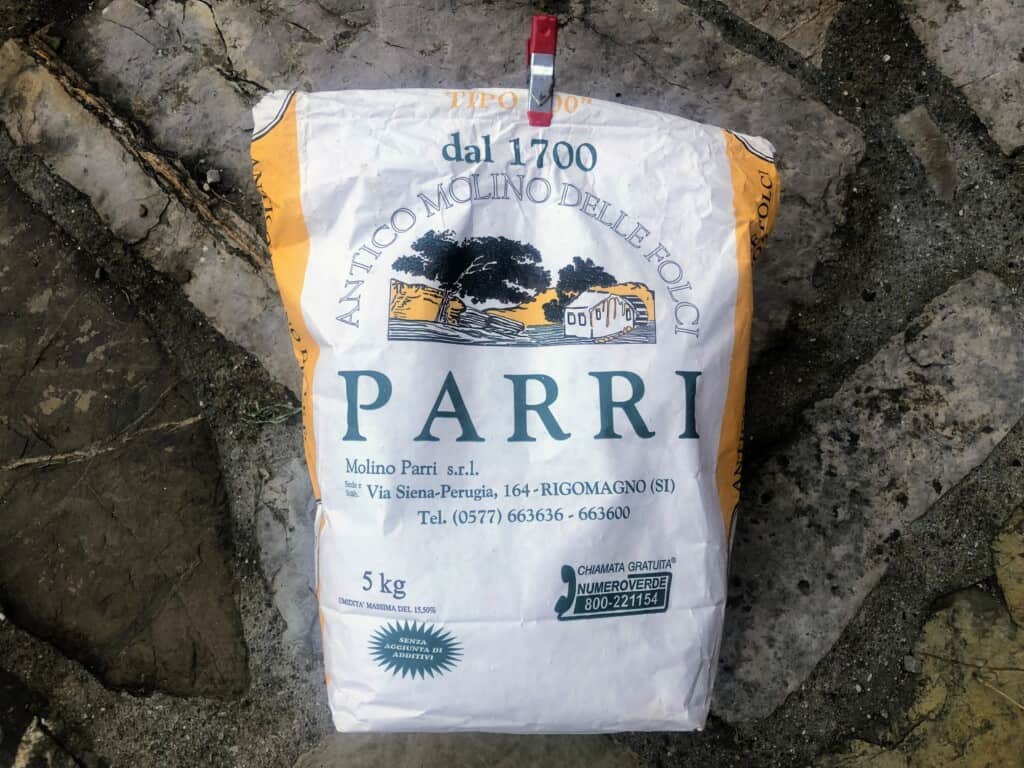
In Italy there are two main types of pizza: Neapolitan-style pizzas which are puffy and chewy and secondly, thin-crust pizza, which is very crisp and crunchy.
Neapolitan pizza dough should be made with a flour with a higher protein index around 12%. Farina tipo 0, 1 or 2 will work well. Try mixing them for different flavor profiles! Real Italian pizzerias will use a special high-gluten 00 flour with a 14+ protein level to allow for a slow rise that will lend a puffy, chewy pizza. At the end of the day, the stronger the flour or w-value, the better!
Fact: The higher the protein content, the longer the dough will need to rise or proof.
For thin crust pizza, farina tipo 00 (low in protein, around 8%) should work well. If you can’t find a 00 that is that low, go for a tipo 1 or tipo 0, with a gluten content around 10% and it should work just fine.
My favorite is using a 50/50 mixture of farina 2 and farina 0 for pizza because it adds a nice, nutty flavor. I typically make a yeasted slow-rise dough, around 72 hours.
Make It: Use our Authentic Pizza Sauce Recipe – Straight from Italy!
Best Italian Flour for Pasta
Just like pizza, the type of pasta you want to make will determine the kind of flour you use.
The golden rule is to keep the protein levels high so go for a stronger flour if possible to add elasticity to your pasta dough. It doesn’t really matter what kind of flour you are using as long as it’s a strong flour (12%+).
In southern Italy, they use a lot more grano duro for making pasta. For fresh egg pasta, go for a farina tipo 00 (grano tenero).
Whole wheat flours will make a nuttier pasta flavor with a coarser texture. The more refined flavor will be a much smoother texture. It’s all a matter of personal preference, so do a bit of experimenting.
Where to Buy Italian Flour Outside of Italy
Check out specialty grocery stores for the biggest variety of flours directly from Italy.
If you are looking for American alternatives such as good, high-quality flours, try King Arthur Flour (they have a huge selection and you can purchase online, find the most common flours in larger supermarkets or visit their store in Norwich, VT for their full selection).
Today, Amazon has plenty of options as well (see direct links in table), both American and Italian brands.
Italian Flour FAQ
Depends on the region and type of bread that is being made. In northern Italy, they tend to use a lot more rye and whole wheat breads while in the central regions grano tenero is preferred and in the south you will find that grano duro is most popular (it grows very well in warmer climates which is the reason it is preferred).
Most Italians store flour as us Americans do: tightly sealed and away from heat or light. If you don’t use flour quickly, seal it in a ziplock bag or closed container. If, however, you use a lot of flour, just close the bag tightly with a clip.
The shelf life of Italian flour is about a year so if you don’t use it, throw away what you have and re-purchase.
If you find you don’t use a specific flour very often, keep a small package tightly sealed in the refrigerator. Flours with more germ and bran tend to attract more bugs and months.
You can purchase 1kg bags (and sometimes larger) of flour in all varieties almost anywhere food is sold. If you want larger bags, check out your local bakery for freshly milled flour from local sources (this is what I do).



